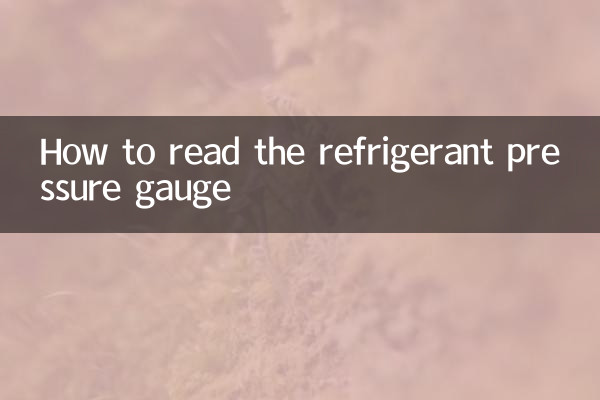How to read the refrigerant pressure gauge
With the advent of high temperatures in summer, the demand for air conditioning repairs and refrigerant (refrigerant) has increased significantly. Many users and maintenance novices are confused about how to correctly read the refrigerant pressure gauge. This article will introduce in detail how to use the refrigerant pressure gauge, combined with hot topics and hot content in the past 10 days, to help you quickly master this skill.
1. Basic structure of refrigerant pressure gauge

The refrigerant pressure gauge usually consists of the following parts:
| Part name | Function description |
|---|---|
| High voltage meter | Display the high pressure at the compressor outlet in MPa or psi |
| Low pressure gauge | Displays the low pressure at the compressor inlet in MPa or psi |
| Connecting pipe | For connecting pressure gauges and air conditioning systems |
| valve | Control the flow direction of refrigerant |
2. How to read the pressure gauge correctly
1.Connect pressure gauge: First turn off the power of the air conditioner, and connect the connecting pipes of the pressure gauge to the high-pressure and low-pressure interfaces of the air-conditioning system. Make sure the connections are tight to avoid leaks.
2.Start the air conditioner: Turn on the air conditioner and set it to cooling mode, adjust the temperature to the lowest and the fan speed to the highest. Wait 5-10 minutes for the system to stabilize.
3.Read pressure value: Observe the pointer positions of the high-voltage and low-voltage gauges. Under normal circumstances, the reading of the high-pressure gauge should be 1.5-2.0MPa (approximately 220-290psi), and the reading of the low-pressure gauge should be 0.4-0.6MPa (approximately 58-87psi).
| pressure type | Normal range (MPa) | Normal range (psi) |
|---|---|---|
| high pressure | 1.5-2.0 | 220-290 |
| low pressure | 0.4-0.6 | 58-87 |
4.Determine refrigerant status: If the pressure value is lower than the normal range, it means there is insufficient refrigerant; if the pressure value is higher than the normal range, there may be too much refrigerant or there are other problems with the system.
3. Hot topics and content in the past 10 days
Recently, topics related to air conditioning repair and refrigerant refilling have sparked widespread discussion on social media. The following are hot topics and hot content in the past 10 days:
| hot topics | Hot content |
|---|---|
| Demand for air conditioning repair surges in hot weather | Temperatures in many places have exceeded 40°C, and air conditioning maintenance technicians are in short supply. |
| DIY refrigerant tutorial | Netizens share their experience of adding refrigerant, sparking safety controversy |
| Refrigerant price fluctuations | Affected by raw materials, refrigerant prices increased by 20% year-on-year |
| Air Conditioning Repair Scam | Consumers complained that some maintenance staff falsely charged for additional refrigerant types. |
4. Precautions
1.Safety first: Be sure to wear protective gloves and goggles when adding refrigerant to avoid refrigerant contact with skin or eyes.
2.Professional operation: If you are not familiar with the air conditioning system, it is recommended to contact professional maintenance personnel to avoid equipment damage or personal injury caused by improper operation.
3.environmental awareness: Refrigerants are hazardous substances and should be disposed of in accordance with local environmental protection regulations to avoid environmental pollution.
5. Summary
Correctly reading the refrigerant pressure gauge is an important skill in air conditioning repair and maintenance. Through the introduction of this article, you should already understand the basic structure, reading method and related precautions of the pressure gauge. The demand for air conditioner repairs has surged under the recent hot weather, but consumers also need to be wary of repair scams. If you are unfamiliar with the operation, it is recommended to seek professional help to ensure safety and effectiveness.
I hope this article can help you better understand and master the use of refrigerant pressure gauge to protect your coolness in summer!

check the details

check the details